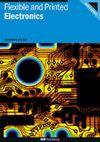Additively manufactured microstrip patch antennas in flat, curved, and embedded configurations
IF 3.2
4区 工程技术
Q3 MATERIALS SCIENCE, MULTIDISCIPLINARY
引用次数: 0
Abstract
Microstrip patch antennas (MPAs) are compact and easy-to-fabricate antennas, widely used in long-distance communications. MPAs are commonly fabricated using subtractive methods such as photolithographic etching of metals previously deposited using sputtering or evaporation. Despite being an established technique, subtractive manufacturing requires various process steps and generates material waste. Additive manufacturing (AM) techniques instead allow optimal use of material, besides enabling rapid prototyping. AM methods are thus especially interesting for the fabrication of electronic components such as MPAs. AM methods include both 2D and 3D techniques, which can also be combined to embed components within 3D-printed enclosures, protecting them from hazards and/or developing haptic interfaces. In this work, we exploit the combination of 2D and 3D printing AM techniques to realize three MPA configurations: flat, curved (at 45∘), and embedded. First, the MPAs were designed and simulated at 2.3 GHz with a −16.25 dB平面、曲面和嵌入式配置的叠加制造微带贴片天线
微带贴片天线(MPA)是一种结构紧凑、易于制造的天线,广泛应用于长距离通信领域。微带贴片天线通常采用减法制造,例如对之前通过溅射或蒸发沉积的金属进行光刻蚀刻。尽管这是一种成熟的技术,但减法制造需要各种工艺步骤,并会产生材料浪费。而增材制造(AM)技术除了能快速制作原型外,还能优化材料的使用。因此,AM 方法尤其适用于制造 MPA 等电子元件。增材制造方法包括二维和三维技术,这两种技术还可以结合起来,将元件嵌入三维打印的外壳中,使其免受危险和/或开发触觉界面。在这项工作中,我们结合二维和三维打印 AM 技术,实现了三种 MPA 配置:平面、曲面(45∘)和嵌入式。首先,我们设计并模拟了 2.3 GHz 频率下的 MPA,其 S11 值为 -16.25 dB。然后,使用聚乳酸通过熔融沉积建模技术三维打印 MPA 介质基板,并使用三种不同的 AM 方法沉积天线材料(导电银墨):丝网印刷、水转印和注射器注射。制备的 MPA 在 2.2-2.4 GHz 频率范围内完全正常工作,与弧形和嵌入式 MPA 相比,平面 MPA 的 S11 峰值更高。这项工作中展示的各种配置的 AM MPA 的开发,可以快速开发出长距离天线,用于航空航天和物联网等领域的新型应用。
本文章由计算机程序翻译,如有差异,请以英文原文为准。
求助全文
约1分钟内获得全文
求助全文
来源期刊

Flexible and Printed Electronics
MATERIALS SCIENCE, MULTIDISCIPLINARY-
CiteScore
4.80
自引率
9.70%
发文量
101
期刊介绍:
Flexible and Printed Electronics is a multidisciplinary journal publishing cutting edge research articles on electronics that can be either flexible, plastic, stretchable, conformable or printed. Research related to electronic materials, manufacturing techniques, components or systems which meets any one (or more) of the above criteria is suitable for publication in the journal. Subjects included in the journal range from flexible materials and printing techniques, design or modelling of electrical systems and components, advanced fabrication methods and bioelectronics, to the properties of devices and end user applications.
 求助内容:
求助内容: 应助结果提醒方式:
应助结果提醒方式:


